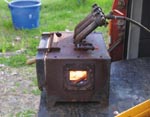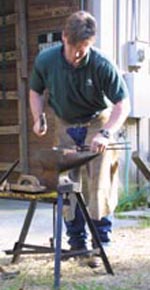His ‘feel for steel’ serves him well in medicine
Upon meeting Marshall Martin, it’s obvious that something is different
about him.
 Fourth-year
student Marshall Martin finishes fitting a horse with custom shoes.
Fourth-year
student Marshall Martin finishes fitting a horse with custom shoes.
The strong handshake, the scuffed boots, and the physical stature of someone who would be as comfortable tossing inebriated patrons out of a bar as he would be writing prescriptions—these are not the traits of a typical medical student.
Then again, the life of the fourth-year student and aspiring orthopaedic surgeon is anything but typical.
Two or three times a week, after long days at MUSC, he loads a toolbox, forge, and anvil into the back of a restored Toyota Land Cruiser (Land Cruiser restoration being another of his hobbies). Then Martin and his Australian shepherd, Taylor, leave the tumult of downtown Charleston, driving until fenceposts replace street lamps and concrete gives way to grass and soil, where the next of his clients’ horses waits to be shod.
Martin is a farrier.
 Martin's
forge prepares a horseshoe for shaping.
Martin's
forge prepares a horseshoe for shaping.
He recognizes the skepticism that many people have towards farriering, but he laughs at the profession’s stereotype.
“Most people think of a farrier as a big brute, mindlessly pounding nails into a horse’s hoof,” he said, “Well, they’re half right. It’s a physically demanding job.”
Still, Martin says there’s more to his job than a hammer and nails.
“Shoeing horses isn’t just about brute force,” he explained. “A good blacksmith has great technical skills. Working with metal is an art; you have to have an intrinsic feel for the steel.”
 Martin
prepares a shoe for one of his client's horses.
Martin
prepares a shoe for one of his client's horses.
Backing up his assertion, Martin takes pride in forging his own horseshoes. He admitted that many farriers will buy stock shoes and “just throw ‘em on the horse,” but Martin carefully crafts his horseshoes based on each horse’s characteristics.
Such attention to detail reveals a deeply rooted pride in his trade.
Martin’s love for smithing began when he was 12 years old. Growing up on a farm in Marion, he helped his father trim the hooves of the family’s horses. At that time, Martin believed that shoeing a horse was something he needed to learn how to do.
“I don’t know why, but I have this mental list of things that I feel I should know or do in my lifetime,” he said. “Shoeing a horse happened to fall into that category.”
 Although
he learned a bit about shoeing horses from his father, Martin never seriously
considered becoming a farrier. When life presented him with other opportunities,
he gladly pursued them.
Although
he learned a bit about shoeing horses from his father, Martin never seriously
considered becoming a farrier. When life presented him with other opportunities,
he gladly pursued them.
After high school, he left his hometown in favor of Colorado Springs, where he attended the U.S. Air Force Academy. During his time as a cadet, he joined the intercollegiate rodeo circuit, riding bulls and competing in team-roping events throughout the western states. Later, he worked as a photojournalist in the Air Force, a position that allowed him to travel across much of the United States, Europe, and Africa.
Despite the whirlwind of activities that shaped his late teenage years and early twenties, Martin still sought a profession about which he could be truly passionate. Only after completing his military service did he stumble upon a hobby that would evolve into a career.
His interest in farriering stood aside until 1994, when he applied to MUSC. After he was placed on the wait list, he put his plans to be a surgeon on hold and instead went to farrier school during the summer. It was a move that would shape the next several years of his life.
“Even with my childhood experiences on the farm, I went to farrier school and realized I knew almost nothing about the trade,” Martin said. Still, he possessed a natural aptitude as a blacksmith and threw himself into learning more.
First, he went to a farrier competition. Armed with a straight piece
of steel and a set of smithing tools, participating blacksmiths competed
to make the best horseshoe within a specific time limit.
“I was enthralled,” Martin recalled.
Around that time, he met Jack Schwartz, another farrier whom Martin called “instrumental” in his development within the trade. Martin believes that if you want to be good at something, you have to learn from the best. In that sense, Schwartz became his friend and mentor.
Martin learned more about the trade and eventually became a full-time farrier. His love for the work combined with the freedom of being self-employed made him feel comfortable with his decision to bypass medical school.
“The farrier life is awesome,” Martin said. “I’d roll out of bed, get some breakfast before daylight, grab a cup of coffee, jump into my truck with my dog, and hit the road to work.”
The quiet simplicity of the job was satisfying in its own right. Martin claimed that through his work, he knew every back road and country store in the region.
Other people noticed the appeal of being a farrier, too. When a friend visited Martin during a Christmas break, he spent a day riding with the farrier as Martin visited various customers. At the end of the day, the friend turned to him, asking, “Are you sure you want to give up this lifestyle?”
Martin began seriously considering the question. When he became a farrier, he thought he’d found a job that would last the rest of his life. But despite his love for the trade, he began to ask himself if he’d be truly happy knowing that he’d only shod horses for a living.
Although many years had passed since his childhood on the family farm, this grown man shared many characteristics with the 12-year-old who had a mental list of everything he wanted to do in life.
In the end, the answer to his friend’s question—was it worth giving up the farrier lifestyle?—was yes. Martin put his farrier duties on hold and returned to medical school.
The choice wasn’t easy. He wanted to try something new, but he’d miss the interaction with his customers and the lifestyle he had led. He also hesitated to abandon a trade that he’d worked so hard to perfect. But his love for the clinical aspect of medicine greatly influenced his decision.
Convinced that medical school was in his future, he reapplied to MUSC and was accepted. Although he still worked a few days each week as a farrier, Martin devoted most of his time to becoming a surgeon. He found that being a farrier gave him some unique insight into the medical field.
“When you’re working with steel, you learn to work with an obstacle, not against it,” he explained. “To be successful, you have to improvise and use the resources on hand.”
Martin applied the same idea to problems in clinical practice, using his improvisational nature in pressure situations.
In addition, his interaction with horse owners prepared him to deal with the interpersonal aspect of medical school. As a farrier, he often served as a confidante for people while shoeing their horses. The experience strengthened his skills in communicating with patients on a personal level.
Now, Martin tries to manage both careers. He attends MUSC full time
and works with horses a few days each week.
Although his schedule is tight, Martin likes the idea of having so
much to do. “After I’m finished at MUSC, I’d rather have too many interests
than none,” he said.
Splitting time between medical school and farriering also gave Martin a new understanding of his life.
“Spending a few days each week shoeing horses helps me remember what I don’t like about the job,” he said. “It’s human nature to focus only on the really great or really bad parts about your past. If I’d committed myself solely to medical school, I’d probably look back at my time as a farrier and reevaluate my decision to become a doctor.”
Staying involved in both fields gives Martin a more realistic view. He understands that in every profession, there are good days and bad days. No job is perfect.
“I love being a farrier, and I love what I’m doing at MUSC,” he concluded.
“I’ll never second-guess my decision to do both.”
Friday, June 25, 2004
Catalyst Online is published weekly, updated
as needed and improved from time to time by the MUSC Office of Public Relations
for the faculty, employees and students of the Medical University of South
Carolina. Catalyst Online editor, Kim Draughn, can be reached at 792-4107
or by email, catalyst@musc.edu. Editorial copy can be submitted to Catalyst
Online and to The Catalyst in print by fax, 792-6723, or by email to petersnd@musc.edu
or catalyst@musc.edu. To place an ad in The Catalyst hardcopy, call Community
Press at 849-1778.